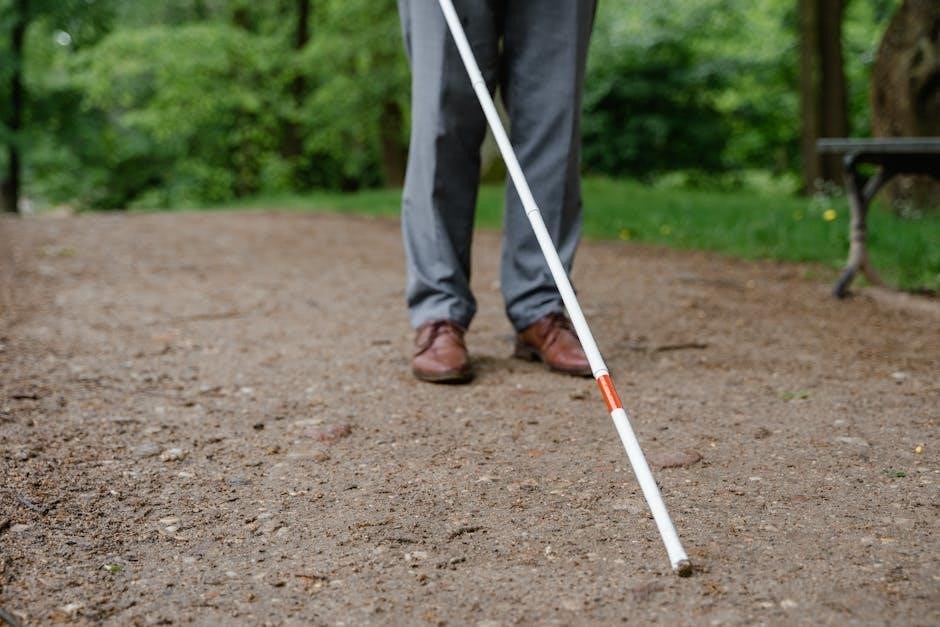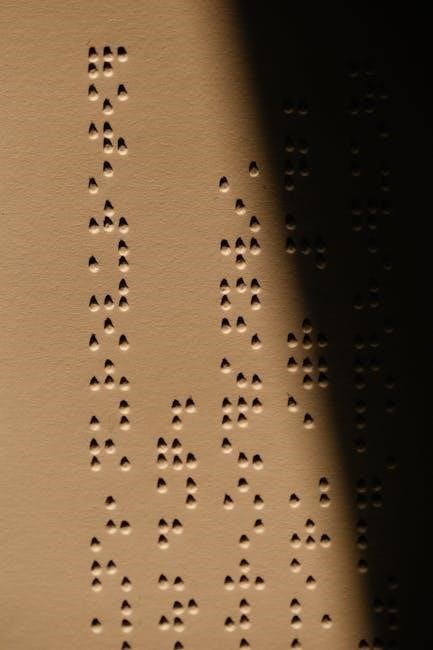
MoCA-BLIND is a specialized cognitive assessment tool designed for visually impaired individuals. It evaluates various cognitive functions, including memory, language, and problem-solving skills, ensuring accurate and reliable results.
What is MoCA-BLIND?
MoCA-BLIND is an adapted version of the Montreal Cognitive Assessment (MoCA), specifically designed for individuals with visual impairments. It eliminates visual-dependent tasks, ensuring equitable cognitive evaluation. The test assesses key cognitive domains such as memory, language, executive functions, and orientation. MoCA-BLIND retains the original MoCA’s effectiveness while accommodating visual limitations, making it a valuable tool for clinicians. It is widely used for screening mild cognitive impairment and is available in PDF format for easy administration and accessibility.
Importance of Cognitive Assessment in Visually Impaired Individuals
Cognitive assessments are crucial for visually impaired individuals to identify potential impairments early. Visual impairments often limit the use of standard cognitive tests, which rely heavily on visual elements. MoCA-BLIND addresses this gap by providing an equitable evaluation of cognitive functions. Early detection of cognitive issues in visually impaired populations enables timely intervention and support. This adaptation ensures that individuals with visual limitations receive accurate assessments, promoting better healthcare outcomes and improved quality of life. Regular cognitive screening is vital for monitoring and managing cognitive health effectively.

Design and Development of MoCA-BLIND
MoCA-BLIND was developed by adapting the original MoCA to accommodate visually impaired individuals. It ensures accessibility while maintaining the integrity of cognitive assessment, fostering inclusivity in healthcare.
Adaptation of the Original MoCA for Visually Impaired Individuals
MoCA-BLIND was created by modifying the standard MoCA to suit visually impaired individuals. Visual-dependent sections were removed or adapted, focusing on auditory and tactile methods. The test retains key cognitive domains like memory, language, and executive functions, ensuring comprehensive assessment without visual bias. Developed in collaboration with experts, MoCA-BLIND maintains the original tool’s reliability while addressing the unique needs of visually impaired populations, making it an essential resource for inclusive cognitive evaluation.
Key Features of the MoCA-BLIND Test
MoCA-BLIND is a concise, 22-point assessment tool designed for visually impaired individuals. It evaluates cognitive domains such as memory, language, attention, and executive functions through non-visual tasks. The test requires approximately 10 minutes to administer and scores range from 0 to 22, with a threshold of 18 indicating normal cognition. Its adaptability and focus on auditory and tactile methods ensure accessibility and accuracy in assessing cognitive function in visually impaired populations.

Structure and Content of MoCA-BLIND
MoCA-BLIND consists of a structured, non-visual assessment evaluating memory, language, attention, and executive functions. It includes tasks like word recall, sentence repetition, and cognitive flexibility, tailored for visually impaired individuals.
Cognitive Domains Assessed in MoCA-BLIND
MoCA-BLIND evaluates multiple cognitive domains, including memory, language, attention, executive functions, and visuospatial abilities. The memory domain involves word recall and recognition. Language assessment includes sentence repetition and verbal fluency. Attention and executive functions are tested through tasks like digit span and cognitive flexibility. Visuospatial skills are addressed without reliance on visual inputs, ensuring accessibility for visually impaired individuals. This comprehensive approach ensures a thorough evaluation of cognitive function, tailored to accommodate visual impairments while maintaining standard assessment integrity.
Detailed Breakdown of Test Items
MoCA-BLIND consists of 22 points across various tasks. Memory is assessed through word recall and recognition. Language skills include sentence repetition and verbal fluency. Attention and executive functions are evaluated using digit span and cognitive flexibility tasks. Visuospatial abilities are tested without visual reliance. Each item is designed to accommodate visual impairments, ensuring accessibility and accuracy. The test structure ensures a comprehensive evaluation of cognitive domains, providing a reliable assessment of cognitive function in visually impaired individuals. This breakdown ensures clarity in test administration and scoring.

Administration Guidelines for MoCA-BLIND
MoCA-BLIND requires approximately 5-10 minutes to administer. It includes a total of 22 points, with a threshold score of 18 indicating normal cognition. The test is adapted for visually impaired individuals, ensuring accessibility and accurate assessment of cognitive function without reliance on visual elements. Administrators should follow standardized instructions to ensure consistency and reliability in results.
Step-by-Step Instructions for Test Administration
Begin by introducing the test and its purpose to the participant. Ensure the individual is comfortable and free from distractions. Read the list of words aloud, asking the participant to repeat them. Conduct two trials, even if the first is successful. Assess attention by asking the participant to tap their hand when hearing specific words. Evaluate language skills through sentence repetition and naming tasks; Conclude with a delayed recall of the word list. Score each section based on accuracy, summing the points for a total score out of 22. Ensure all instructions are delivered clearly and consistently to maintain test reliability.
Time Required to Complete the Test
The MoCA-BLIND test typically takes approximately 5-10 minutes to administer. This brief duration ensures efficiency while still assessing key cognitive domains such as memory, language, and problem-solving abilities. The streamlined design allows for quick evaluation without compromising the accuracy of results. Administering the test in a calm, distraction-free environment is recommended to ensure optimal performance. The short time frame makes it practical for clinical settings, enabling healthcare professionals to rapidly assess cognitive function in visually impaired individuals effectively.

Scoring and Interpretation of MoCA-BLIND
The MoCA-BLIND test has a maximum score of 22, with scores of 18 or above indicating normal cognition. It effectively screens for cognitive impairments.
Scoring Criteria and Maximum Possible Score
The MoCA-BLIND scoring system evaluates cognitive domains with a maximum score of 22. Each task within the test contributes to the total, ensuring a comprehensive assessment of cognitive function. Higher scores indicate better cognitive performance, while lower scores may suggest impairments. The scoring criteria are designed to be objective, allowing for consistent and reliable results across administrations. This system helps clinicians accurately interpret cognitive status and make informed decisions.
Interpretation of Results and Threshold for Normal Cognition
The MoCA-BLIND results are interpreted based on a maximum score of 22, with a threshold of 18 or above indicating normal cognitive function. Scores below 18 suggest potential cognitive impairment. This cutoff helps clinicians identify individuals who may require further evaluation or intervention. The test’s design ensures that visual impairment does not affect the scoring, making it a reliable tool for assessing cognitive status in visually impaired populations. Accurate interpretation aids in early detection and monitoring of cognitive changes.

Clinical Applications of MoCA-BLIND
MoCA-BLIND is widely used in diagnostic settings to assess cognitive impairments in visually impaired individuals. It aids clinicians in identifying and monitoring cognitive changes effectively.
Use in Diagnostic Settings for Cognitive Impairments
MoCA-BLIND is a valuable tool in clinical settings for diagnosing cognitive impairments in visually impaired individuals. Its structured format allows healthcare professionals to assess memory, executive functions, and language abilities accurately. The test is particularly effective in identifying mild cognitive dysfunction, which is crucial for early intervention. With its quick administration time of 5-10 minutes, MoCA-BLIND is ideal for routine check-ups and monitoring cognitive changes over time. This adaptability makes it a preferred choice for clinicians working with visually impaired populations.
Application in Research Studies on Cognitive Function
MoCA-BLIND is widely used in research to study cognitive function, particularly in visually impaired populations. Its standardized design ensures consistent data collection, while its brevity makes it ideal for large-scale studies. The test’s ability to detect mild cognitive impairment is crucial for tracking progression and evaluating interventions. Its adaptability and validation through extensive peer-reviewed studies make it a reliable tool for exploring cognitive trends and enhancing understanding of impairment in special populations, aiding in the development of targeted therapies.
Reliability and Validity of MoCA-BLIND
MoCA-BLIND is a reliable and validated tool, supported by over 7,000 studies, ensuring accuracy in assessing cognitive function in visually impaired populations effectively.
Concurrent Reliability with Other Cognitive Assessments
MoCA-BLIND demonstrates strong concurrent reliability with other cognitive assessments, such as the Symbol Digit Modalities Test (SDMT). Studies show consistent results across tools, validating its effectiveness in detecting cognitive impairments. This alignment ensures that MoCA-BLIND can be confidently used alongside other established measures, providing a comprehensive understanding of cognitive function in visually impaired individuals. Its reliability is further supported by its adaptation from the widely validated original MoCA, maintaining high sensitivity and specificity.
Validity in Assessing Cognitive Impairment in Visually Impaired Populations
MoCA-BLIND has been proven to be a valid tool for assessing cognitive impairment in visually impaired individuals. By removing visual-dependent tasks, it ensures accurate measurement of cognitive functions without bias. Studies confirm its effectiveness in detecting mild cognitive dysfunction, making it a reliable instrument for clinicians. The tool’s adaptation specifically addresses the needs of this population, providing a fair and accurate assessment of their cognitive abilities compared to standard tests.

Comparison with Other Cognitive Assessment Tools
MoCA-BLIND stands out as a specialized tool for visually impaired individuals, unlike standard cognitive assessments. Its design excludes visual-dependent tasks, making it uniquely effective for this population.
Differences from the Standard MoCA Test
MoCA-BLIND is specifically adapted for visually impaired individuals, removing tasks that require visual processing like drawing or reading. It focuses on verbal and auditory assessments to ensure accessibility. Unlike the standard MoCA, which includes visual-dependent tasks, MoCA-BLIND relies on memory, language, and executive function evaluations. The scoring system is adjusted to reflect the removal of visual components, providing a fair assessment for those with visual impairments. This adaptation ensures that cognitive function is measured accurately without bias related to visual ability.
Comparison with Other Tests for Visually Impaired Individuals
MoCA-BLIND stands out as a concise, 5-10 minute assessment tailored for visually impaired individuals, focusing on auditory and verbal tasks. Unlike other tools, it avoids visual dependencies, making it uniquely accessible. Its streamlined design ensures efficiency while maintaining comprehensive cognitive evaluation. By adapting the original MoCA, it bridges gaps in existing assessments, offering a reliable and valid measure of cognitive function for this population, setting it apart from other tests that may not adequately address visual impairments.

Case Studies and Practical Examples
MoCA-BLIND is widely used in clinical settings to assess cognitive function in visually impaired individuals, providing practical insights into diagnosis and rehabilitation strategies effectively.
Real-World Applications of MoCA-BLIND in Clinical Practice
MoCA-BLIND is effectively utilized in clinical settings to assess cognitive impairments in visually impaired patients. It aids in early detection of dementia and monitoring therapeutic progress. The test’s adaptability ensures accurate evaluation without relying on visual elements, making it a valuable tool for clinicians. Its brevity and ease of administration allow for quick assessments during routine check-ups, facilitating timely interventions. This has proven particularly beneficial in geriatric care, where visual impairments are common among elderly patients.
Examples of Test Administration and Interpretation
In clinical practice, MoCA-BLIND is administered by reading word lists aloud for memory recall and guiding participants through tasks verbally. For instance, a visually impaired patient with a score of 20 out of 22 may indicate mild cognitive impairment, while a score of 18 or above suggests normal cognition; Clinicians interpret results by comparing them to established thresholds, ensuring accurate assessments and appropriate interventions.

Downloading and Accessing MoCA-BLIND PDF
The MoCA-BLIND test is available for free download as a PDF, specifically designed for visually impaired individuals. It can be accessed online in English version 8.1.
Availability of MoCA-BLIND in PDF Format
The MoCA-BLIND is readily available in PDF format, ensuring easy accessibility for clinicians and researchers. The PDF document includes all necessary sections for patient assessment, such as personal information fields and test instructions. Users can download it free of charge from various online platforms, with versions like 7.1 and 8.1 being the most commonly accessed. This format allows for seamless printing and digital sharing, making it a practical tool for cognitive evaluation in visually impaired populations.
Steps to Download and Use the Test
To access the MoCA-BLIND, visit authorized websites and search for “MoCA-BLIND PDF.” Select the desired version, such as 7.1 or 8.1, and download the document. Ensure the PDF is printed on standard paper for administration. Administer the test by following the instructions provided, which include reading word lists and guiding the participant through each section. Scores are calculated based on correct responses, with a maximum of 22 points. Interpretation guidelines are included to determine cognitive status accurately.

Benefits and Limitations of MoCA-BLIND
MoCA-BLIND is accessible for visually impaired individuals, ensuring fair cognitive assessment. Its concise format makes it efficient, but it may lack depth in visual-related cognitive evaluations.
Advantages of Using MoCA-BLIND for Cognitive Assessment
MoCA-BLIND offers a reliable and accessible method for assessing cognitive function in visually impaired individuals. Its design eliminates visual reliance, ensuring fair evaluation. The test is efficient, requiring only 5-10 minutes to administer, and covers key cognitive domains like memory, language, and executive functions. It is validated for use in clinical and research settings, providing consistent and accurate results. Additionally, its availability in PDF format makes it easily accessible for professionals worldwide.
Potential Limitations and Challenges
MoCA-BLIND’s reliance on auditory and tactile methods can pose challenges for individuals with hearing or sensory impairments. The test’s scoring threshold may not account for all cognitive nuances, potentially missing subtle impairments. Additionally, its adaptation from the standard MoCA might limit its sensitivity in certain cognitive domains. Accessibility issues can arise for non-English speakers, and the need for trained administrators ensures proper test execution. These factors highlight the need for careful consideration in its application.
Future Directions and Updates
MoCA-BLIND is undergoing updates to enhance accessibility, including digital formats and multilingual support, ensuring broader reach and inclusivity for visually impaired individuals worldwide.
Planned Updates and Improvements to MoCA-BLIND
Planned updates to MoCA-BLIND include enhancing its digital accessibility, ensuring compatibility with assistive technologies like screen readers. Additional features will include multilingual support to cater to a global audience. The test items will be refined for better accuracy and cultural relevance. Future improvements aim to expand the test’s applicability across diverse populations and integrate user feedback for enhanced usability. These updates will be developed in collaboration with cognitive experts and user groups to ensure relevance and effectiveness, aligning with the latest advancements in cognitive assessment for visually impaired individuals.
Potential Expansion to Other Special Populations
MoCA-BLIND’s success with visually impaired individuals has sparked interest in adapting it for other special populations. Future plans include tailoring the test for hearing-impaired, motor-disabled, and individuals with learning disabilities. Researchers aim to create versions with enhanced accessibility, such as visual or tactile formats for the hearing-impaired and simplified response methods for motor-disabled individuals. Additionally, cultural and linguistic adaptations are being explored to make MoCA-BLIND accessible to diverse global populations, ensuring equitable cognitive assessment opportunities for all.